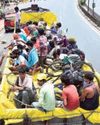Cattle traders see a nexus between cow vigilantes and animal rights organisations in Delhi, where vigilantes unleashed violence in April. In the past year, 40,000 animals seized by them were not returned to the owners, and traders believe that they were sold.

A PLANNED and brutal assault on cattle traders in Kalkaji in Delhi on April 22 by a mob of gau rakshaks (cow protectors) has brought to the fore the issue of cow vigilantism that has been rampant in the capital. Since the Bharatiya Janata Party (BJP) government came to power at the Centre in 2014, instances of violence by gau rakshaks have increased in Delhi.
However, representatives of the Buffalo Traders Welfare Association say the seizure of animals and the harassment of cattle traders by animal rights organisations go back a long way. In most cases, first information reports (FIRs) were registered and court proceedings initiated, but they never grabbed media attention. What seems to have changed in the past three years is the degree and nature of the violence against traders while transporting cattle from other States.
“Earlier the moment we reached the borders of Delhi, we would think we were safe, but not in the past few years. Incidents of our vehicles being intercepted by members of the People for Animals or the SGACC [Sanjay Gandhi Animal Care Centre], who call themselves gau rakshaks, are brought to our notice every other day,” said Aquil Qureishi, president of the association.
The attack in Kalkaji attracted
CATTLE TRADERS
Aasu, Rizwan and Kamil, who were attacked by members of animal rights organisations. attention thanks to a video recording of the incident made by the NDTV reporter Radhika Bordia, who was passing by. As the video went viral, the police authorities were pressed into action and the media took note. In some incidents earlier, the transporters and drivers, too scared even to register a complaint, quietly slipped away.
Denne historien er fra May 26, 2017-utgaven av FRONTLINE.
Start din 7-dagers gratis prøveperiode på Magzter GOLD for å få tilgang til tusenvis av utvalgte premiumhistorier og 9000+ magasiner og aviser.
Allerede abonnent ? Logg på
Denne historien er fra May 26, 2017-utgaven av FRONTLINE.
Start din 7-dagers gratis prøveperiode på Magzter GOLD for å få tilgang til tusenvis av utvalgte premiumhistorier og 9000+ magasiner og aviser.
Allerede abonnent? Logg på

How Not To Handle An Epidemic
The lockdowns were meant to buy time to put in place appropriate health measures and contain the coronavirus’ spread, but they have failed to achieve the objective and heaped immense misery on the marginalised sections of society. India is still in the exponential phase of the COVID-19 infection and community transmission is a reality that the government refuses to accept.

Tragedy on foot
As the COVID-19-induced lockdown cuts the ground beneath their feet in Tamil Nadu, thousands of migrant workers are trudging along the highway to the relative safety of their upcountry homes.

Sarpanchs as game changers
Odisha manages to keep COVID-19 well under control because of the strong participation of panchayati raj institutions and the community at the grass-roots level under the leadership of Chief Minister Naveen Patnaik.

Scapegoating China
As the COVID-19 death rate spikes and the economy tanks in the United States, Donald Trump and his advisers target China and the World Health Organisation with an eye to winning the forthcoming presidential election.

New worries
Kerala’s measured approach to the pandemic and lockdown has yielded results. But it still has to grapple with their huge economic impact on its economy, which it feels the Centre’s special financial relief package does little to alleviate.
No love lost for labour
Taking advantage of the lockdown and the inability of workers to organise protests, many State governments introduce sweeping changes to labour laws to the detriment of workers on the pretext of reviving production and boosting the economy.

Capital's Malthusian moment
In a world that needs substantial reorienting of production and distribution, Indian capital is resorting to a militant form of moribund neoliberalism to overcome its current crisis. In this pursuit of profit, it is ready and willing to throw into mortal peril millions whom it adjudicates as not worth their means—an admixture of social Darwinism born of capital’s avarice and brutalism spawned by Hindutva. .

Understanding migration
When governments and their plans are found to be blatantly wanting in addressing reverse migration, exercises such as the Ekta Parishad’s survey of migrant workers throughout India can be useful to work out creative long-lasting solutions.

Waiting for Jabalpur moment
The Supreme Court’s role in ensuring executive accountability during the ongoing lockdown leaves much to be desired. Standing in shining contrast is the record of some High Courts.

An empty package
The Modi regime, which has been unable to control the COVID-19 infection, restore economic activity and provide relief to millions exposed to starvation, trains its sights on Indian democracy, making use of the panic generated by fear and a lockdown that forecloses paths of resistance.